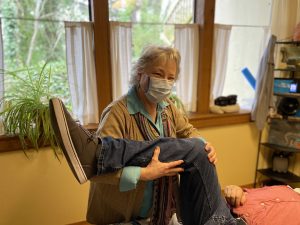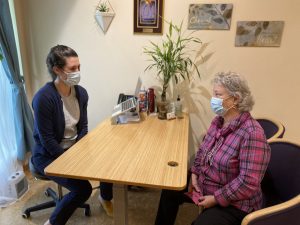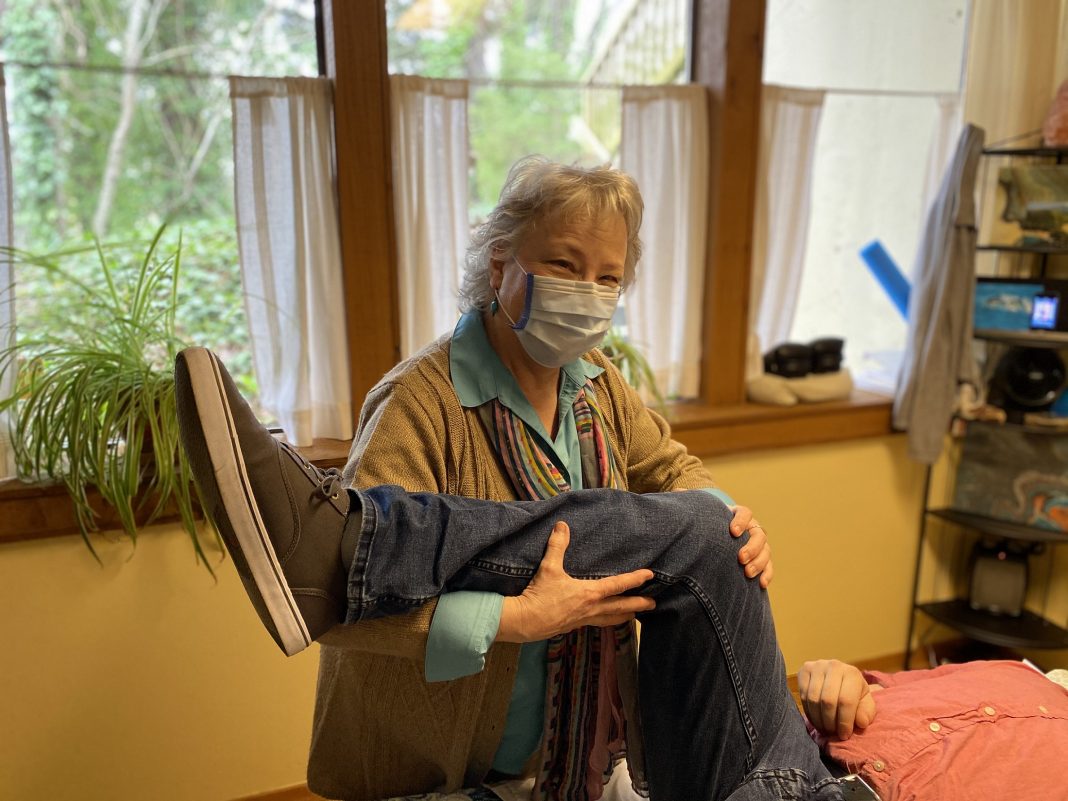Most of us have experienced this at some point. You bend over to tie a shoe or pick something up from the ground and as you attempt to straighten, crack! Out of nowhere, your back goes out. Although such events are more common among people over 40, they can also occur at any age. Back pain affects four out of five people over the course of their lives, and when it strikes, it can be debilitating. At Olympia’s Heart of Wellness, physical therapist Maia O’Brien recently joined the practice to contribute another component to the clinic’s integrated healthcare model: relieving back pain.

O’Brien has helped hundreds of patients with back pain in her 35-year career. Having her on the team is beneficial in multiple ways, according to Dr. Morgan Schuster, particularly when it comes to consulting on the next steps for patients based on what x-rays or MRIs reveal. “I can consult with her about the images and whether or not the patient needs physical therapy or in some cases, surgery,” Schuster explains. “As a clinician, I’m a generalist so it helps to have an expert in how the body should move.”
By the time patients visit the clinic, they’ve often tried other approaches to addressing back pain, especially in cases where the injury has been recurrent. O’Brien helps them understand basic movement principles and how to adhere to a long-term treatment plan to address their condition. The better they understand the principles, the more likely they are to stick with the plan, she notes.
Conditions tend to fall into several main categories: chronic complaints, accidents and sudden onset injuries like in the case of someone who stood up too quickly while gardening or performing some other activity. O’Brien sees many parents whose children still like to be picked up but are now older, and heavier. Three and four-year-olds typically weigh around 40 pounds, enough to cause problems even for younger parents. “I just had a patient who is in her 20s and her back went out while she was picking up her child,” says O’Brien.

Another contingent is made up of older parents or people in their 40s whose initial issues began much earlier. “The first onset of a problem might have been when their kids were young,” O’Brien says. “Since then, they’ve been in a desk job and have started to lose strength because they’re not able to fit in an exercise program. Recurring injuries from 15 to 20 years ago are starting to become more frequent.”
To help such patients, O’Brien uses several tools. She is a certified Laban Movement Analyst who is trained in the McKenzie Method of Physical Therapy and principles of Dynamic Neuromuscular Stabilization. Developed by New Zealand physical therapist Robin McKenzie in the 1960s, the McKenzie Method uses physical therapy and exercises to extend the spine. His book, “Treat Your Own Back,” is best used with support from a trained physical therapist. “Most people benefit from some guidance,” O’Brien explains, “because even if they read it, they might not have understood it or may have applied it in the wrong way because they didn’t know how to develop a consistent, preventative program for long-term success.”
Guidance can also help patients grappling with fear along with back pain. Not knowing the cause or what leads to a flare-up can be terrifying, especially if the condition is interfering with sleep. “They’re stressed and exhausted and need someone who will guide them step by step,” says O’Brien. “It usually takes about four or five visits to go through the McKenzie Model process.”

Another tool is the developmental sequence (think crawling to standing to walking) to assess fundamental movement patterns and see if something is missing or off track. Watching patients do simple activities like reaching overhead or bending down can reveal important information and enables her to prescribe corrective exercises.
The challenge is that patients often have unrealistic expectations about their recovery time. “Most of these injuries will heal if they’re properly treated for the right amount of time,” O’Brien says. “There’s usually a big mismatch between what we think we should be able to do and the actual healing time of the tissue. It’s important that people don’t jump ahead and try to get back to 100% function when they’re only at 20% recovery.” Depending on the condition, healing can take between 4 and 12 weeks.
In some cases, physical therapy obviates the need for surgery by stabilizing the condition and stopping it from getting worse so that healing can begin. If, however, surgery is the only option, physical therapy beforehand can still lead to a better outcome.
Regardless of whether you’re dealing with chronic back pain, were injured in an accident or simply stood up too fast, the team at Heart of Wellness can support your wellness goals and get you on track for healing. Find out more about options for treating back pain by visiting the Heart of Wellness website or calling 360.570.0401.
Sponsored

















































